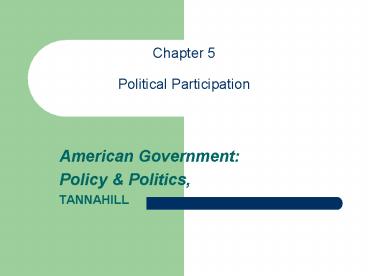Chapter 5 Political Participation - PowerPoint PPT Presentation
1 / 21
Title:
Chapter 5 Political Participation
Description:
Political participation is activity that has the intent or effect of ... Election campaigns are fought over small issues that fail to excite the electorate. ... – PowerPoint PPT presentation
Number of Views:1233
Avg rating:3.0/5.0
Title: Chapter 5 Political Participation
1
Chapter 5Political Participation
- American Government
- Policy Politics,
- TANNAHILL
2
In This Chapter We Will Cover
- Forms of participation
- Explaining participation
- Patterns of participation
- Trends in voter turnout
- Nonvoters
- Participation rates in comparative perspective
- Participation bias
3
Forms of Participation
- Political participation is activity that has the
intent or effect of influencing government
action. - Voting is the most common form of political
participation. - (Turnout in the 2004 presidential race was 56
percent of voting age population.)
4
Forms of Participation
- Contacting elected officials is another form of
political participation. - Some Americans try to influence the policy
process by joining interest groups. - Unconventional political acts like marching and
demonstrating provide another avenue for
political participation.
5
Explaining Participation
- Personal Resources
- Time, money, and civic skills
- Psychological Engagement
- People take part in the policy process when they
have a strong sense of political efficacy (belief
they can influence the policymaking process).
6
Explaining Participation
- Voter mobilization is the process of motivating
citizens to vote. - Community involvement leads people to see voting
and other forms of political participation as a
civic duty.
7
Patterns of Participation
- Income
- Affluence and activity go together for every form
of political participation. - Age
- The American electorate is relatively old and
getting older. In 2002, the number of voters age
65 and older outnumbered younger voters below 30
by a two-to-one margin.
8
Voter Turnout by Age Group, 2000
9
Patterns of Participation
- Race/Ethnicity
- Turnout in 2000 varied by group
- Whites at 60
- African Americans at 54
- Latinos at 28
- Asian Americans at 25
10
Patterns of Participation
- Gender
- Women are more likely to vote, but men are more
likely to engage in other forms of participation.
11
Voter Turnout, 1964-2004
12
Trends in Voter Turnout
- Explaining the Decline in Voter Turnout
- The electorate is younger.
- Party ties are weaker.
- Election campaigns are fought over small issues
that fail to excite the electorate.
13
Trends in Voter Turnout
- Negative campaign advertising causes people to
stay home. - External political efficacy has fallen.
- People are less connected to their communities.
14
Trends in Voter Turnout
- Interest in politics has decreased.
- Many Americans believe that election outcomes
have little impact on policy. - Modern campaign techniques focus on likely
voters, ignoring everyone else.
15
Nonvoters
- People dont vote for a variety of reasons.
- Doers (29 percent of nonvoters) are too busy to
register and vote. - Unpluggeds (27 percent) do not believe the policy
process affects their lives.
16
Nonvoters
- Irritables (18 percent of nonvoters) know what
government is doing and dont like it. - Dont knows (14 percent) are indifferent to
government, and focus instead on jobs and family. - Alienateds (12 percent) are very pessimistic,
they dislike candidates, parties, and
institutions of government.
17
Increasing Voter Turnout
- The 1993 National Voter Registration Act (NVRA),
also known as the Motor Voter Act increased the
number of registered voters but not the number of
actual voters.
18
Participation Rates in Comparative Perspective
- Voting turnout in the U.S. is relatively low
compared to other industrialized democracies.
Three possible reasons - American election procedures are more cumbersome.
- U.S. national parties are weak.
- Separation of powers leads some to think
elections dont impact policy.
19
Participation Bias
- Because participation rates in the U.S. are so
low, some speculate how increased participation
might impact the two major parties or public
policy outcomes.
20
Concluding Review Questions
- What is the most common form of political
participation? - What are the other ways in which people can
participate in the policy process? - How do participation rates vary based on such
factors as income, age, race/ethnicity, and
gender?
21
Concluding Review Questions
- How is voter turnout measured and why do
political scientists disagree about the validity
of the measure? - What reasons do political scientists give to
explain the decline in voter participation rates? - What reforms could be adopted to increase voter
participation?































